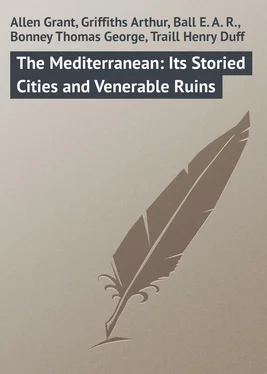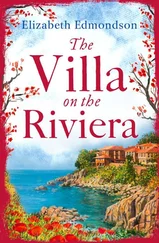E. Ball - The Mediterranean - Its Storied Cities and Venerable Ruins
Здесь есть возможность читать онлайн «E. Ball - The Mediterranean - Its Storied Cities and Venerable Ruins» — ознакомительный отрывок электронной книги совершенно бесплатно, а после прочтения отрывка купить полную версию. В некоторых случаях можно слушать аудио, скачать через торрент в формате fb2 и присутствует краткое содержание. Жанр: Путешествия и география, foreign_prose, foreign_language, на английском языке. Описание произведения, (предисловие) а так же отзывы посетителей доступны на портале библиотеки ЛибКат.
- Название:The Mediterranean: Its Storied Cities and Venerable Ruins
- Автор:
- Жанр:
- Год:неизвестен
- ISBN:нет данных
- Рейтинг книги:3 / 5. Голосов: 1
-
Избранное:Добавить в избранное
- Отзывы:
-
Ваша оценка:
- 60
- 1
- 2
- 3
- 4
- 5
The Mediterranean: Its Storied Cities and Venerable Ruins: краткое содержание, описание и аннотация
Предлагаем к чтению аннотацию, описание, краткое содержание или предисловие (зависит от того, что написал сам автор книги «The Mediterranean: Its Storied Cities and Venerable Ruins»). Если вы не нашли необходимую информацию о книге — напишите в комментариях, мы постараемся отыскать её.
The Mediterranean: Its Storied Cities and Venerable Ruins — читать онлайн ознакомительный отрывок
Ниже представлен текст книги, разбитый по страницам. Система сохранения места последней прочитанной страницы, позволяет с удобством читать онлайн бесплатно книгу «The Mediterranean: Its Storied Cities and Venerable Ruins», без необходимости каждый раз заново искать на чём Вы остановились. Поставьте закладку, и сможете в любой момент перейти на страницу, на которой закончили чтение.
Интервал:
Закладка:
You pass through the gates of the old Moorish town and find yourself at once in a modern but still busy suburb. Then on a sudden the road begins to mount the steep Mustapha slope by sharp zigzags and bold gradients. In native Algerian days, before Allah in his wisdom mysteriously permitted the abhorred infidel to bear sway in the Emerald City over the Faithful of Islam, a single narrow mule-path ascended from the town wall to the breezy heights of Mustapha. It still exists, though deserted, that old breakneck Mussulman road a deep cutting through soft stone, not unlike a Devonshire lane, all moss-grown and leafy, a favorite haunt of the naturalist and the trap-door spider. But the French engineers, most famous of road-makers, knew a more excellent way. Shortly after the conquest they carved a zigzag carriage-drive of splendid dimensions up that steep hill-front, and paved it well with macadam of most orthodox solidity. At the top, in proof of their triumph over nature and the Moslem, they raised a tiny commemorative monument, the Colonne Voirol, after their commander’s name, now the Clapham Junction of all short excursions among the green dells of the Sahel.
The Mustapha road, on its journey uphill, passes many exquisite villas of the old Moorish corsairs. The most conspicuous is that which now forms the Governor-General’s Summer Palace, a gleaming white marble pile of rather meretricious and over-ornate exterior, but all glorious within, to those who know the secret of decorative art, with its magnificent heirloom of antique tiled dados. Many of the other ancient villas, however, and notably the one occupied by Lady Mary Smith-Barry, are much more really beautiful, even if less externally pretentious, than the Summer Palace. One in particular, near the last great bend of the road, draped from the ground to the flat roof with a perfect cataract of bloom by a crimson bougainvillea, may rank among the most picturesque and charming homes in the French dominions.
It is at Mustapha, or along the El Biar road, that the English colony of residents or winter visitors almost entirely congregates. Nothing can be more charming than this delicious quarter, a wilderness of villas, with its gleaming white Moorish houses half lost in rich gardens of orange, palm, and cypress trees. How infinitely lovelier these Eastern homes than the fantastic extravagances of the Californie at Cannes, or the sham antiques on the Mont Boron! The native North African style of architecture answers exactly to the country in whose midst it was developed. In our cold northern climes those open airy arcades would look chilly and out of place, just as our castles and cottages would look dingy and incongruous among the sunny nooks of the Atlas. But here, on the basking red African soil, the milk-white Moorish palace with its sweeping Saracenic arches, its tiny round domes, its flat, terraced roofs, and its deep perspective of shady windows, seems to fit in with land and climate as if each were made for the other. Life becomes absolutely fairy-like in these charming old homes. Each seems for the moment while you are in it just a dream in pure marble.
I am aware that to describe a true Moorish villa is like describing the flavor of a strawberry; the one must be tasted, the other seen. But still, as the difficulty of a task gives zest to the attempt at surmounting it, I will try my hand at a dangerous word-picture. Most of the Mustapha houses have an outer entrance-court, to which you obtain admission from the road by a plain, and often rather heavy, archway. But, once you have reached the first atrium, or uncovered central court, you have no reason to complain of heaviness or want of decoration. The court-yard is generally paved with parti-colored marble, and contains in its center a Pompeian-looking fountain, whose cool water bubbles over into a shallow tank beneath it. Here reeds and tall arums lift their stately green foliage, and bright pond-blossoms rear on high their crimson heads of bloom. Round the quadrangle runs a covered arcade (one might almost say a cloister) of horse-shoe arches, supported by marble columns, sometimes Græco-Roman antiques, sometimes a little later in date, but admirably imitated from the originals. This outer court is often the most charming feature of the whole house. Here, on sultry days, the ladies of the family sit with their books or their fancy-work; here the lord of the estate smokes his afternoon cigar; here the children play in the shade during the hottest African noon-day. It is the place for the siesta, for the afternoon tea, for the lounge in the cool of the evening, for the joyous sense of the delight of mere living.
From the court-yard a second corridor leads into the house itself, whose center is always occupied by a large square court, like the first in ground-plan, but two-storied and glass-covered. This is the hall, or first reception room, often the principal apartment of the whole house, from which the other rooms open out in every direction. Usually the ground-floor of the hall has an open arcade, supporting a sort of balcony or gallery above, which runs right round the first floor on top of it. This balcony is itself arcaded; but instead of the arches being left open the whole way up, they are filled in for the first few feet from the floor with a charming balustrade of carved Cairene woodwork. Imagine such a court, ringed round with string-courses of old Oriental tiles, and decorated with a profusion of fine pottery and native brasswork, and you may form to yourself some faint mental picture of the common remodeled Algerian villa. It makes one envious again to remember how many happy days one has spent in some such charming retreats, homes where all the culture and artistic taste of the West have been added to all the exquisite decorative instinct and insight of the Oriental architect.
Nor are fair outlooks wanting. From many points of view on the Mustapha Hill the prospect is among the most charming in the western Mediterranean. Sir Lambert Playfair, indeed, the learned and genial British Consul-General whose admirable works on Algeria have been the delight of every tourist who visits that beautiful country, is fond of saying that the two finest views on the Inland Sea are, first, that from the Greek Theater at Taormina, and, second, that from his own dining-room windows on the hill-top at El Biar. This is very strong praise, and it comes from the author of a handbook to the Mediterranean who has seen that sea in all aspects, from Gibralta to Syria; yet I fancy it is too high, especially when one considers that among the excluded scenes must be put Naples, Sorrento, Amalfi, Palermo, and the long stretch of Venice as seen from the Lido. I would myself even rank the outlook on Monaco from the slopes of Cap Martin, and the glorious panorama of Nice and the Maritime Alps from the Lighthouse Hill at Antibes, above any picture to be seen from the northern spurs of the Sahel. Let us be just to Piræus before we are generous to El Biar. But all this is, after all, a mere matter of taste, and no lover of the picturesque would at any rate deny that the Bay of Algiers, as viewed from the Mustapha Hill, ranks deservedly high among the most beautiful sights of the Mediterranean. And when the sunset lights up in rosy tints the white mole and the marble town, the resulting scene is sometimes one of almost fairy-like splendor.
Indeed, the country round Mustapha is a district of singular charm and manifold beauty. The walks and drives are delicious. Great masses of pale white clematis hang in sheets from the trees, cactus and aloe run riot among the glens, sweet scents of oleander float around the deep ravines, delicious perfumes of violets are wafted on every breeze from unseen and unsuspected gardens. Nowhere do I know a landscape so dotted with houses, and nowhere are the houses themselves so individually interesting. The outlook over the bay, the green dells of the foreground, the town on its steep acclivity, the points and headlands, and away above all, in the opposite direction, the snow-clad peaks of the Djurjura, make up a picture that, after all, has few equals or superiors on our latter-day planet.
Читать дальшеИнтервал:
Закладка:
Похожие книги на «The Mediterranean: Its Storied Cities and Venerable Ruins»
Представляем Вашему вниманию похожие книги на «The Mediterranean: Its Storied Cities and Venerable Ruins» списком для выбора. Мы отобрали схожую по названию и смыслу литературу в надежде предоставить читателям больше вариантов отыскать новые, интересные, ещё непрочитанные произведения.
Обсуждение, отзывы о книге «The Mediterranean: Its Storied Cities and Venerable Ruins» и просто собственные мнения читателей. Оставьте ваши комментарии, напишите, что Вы думаете о произведении, его смысле или главных героях. Укажите что конкретно понравилось, а что нет, и почему Вы так считаете.












